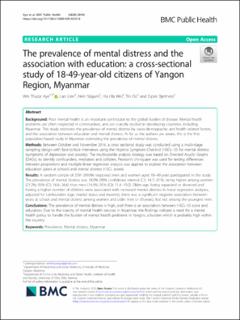| dc.contributor.author | Aye, Win Thuzar | |
| dc.contributor.author | Lien, Lars | |
| dc.contributor.author | Stigum, Hein | |
| dc.contributor.author | Win, Hla Hla | |
| dc.contributor.author | Oo, Tin | |
| dc.contributor.author | Bjertness, Espen | |
| dc.date.accessioned | 2021-02-23T12:35:18Z | |
| dc.date.available | 2021-02-23T12:35:18Z | |
| dc.date.created | 2021-01-25T09:58:42Z | |
| dc.date.issued | 2020 | |
| dc.identifier.citation | BMC Public Health. 2020, 20 (1), . | en_US |
| dc.identifier.issn | 1471-2458 | |
| dc.identifier.uri | https://hdl.handle.net/11250/2729806 | |
| dc.description.abstract | Background: Poor mental health is an important contributor to the global burden of disease. Mental health problems are often neglected in communities, and are scarcely studied in developing countries, including Myanmar. This study estimates the prevalence of mental distress by socio-demographic and health related factors, and the association between education and mental distress. As far as the authors are aware, this is the first population-based study in Myanmar estimating the prevalence of mental distress. Methods: Between October and November 2016, a cross sectional study was conducted using a multi-stage sampling design with face-to-face interviews using the Hopkins Symptom Checklist (HSCL-10) for mental distress (symptoms of depression and anxiety). The multivariable analysis strategy was based on Directed Acyclic Graphs (DAGs), to identify confounders, mediators and colliders. Pearson's chi-square was used for testing differences between proportions and multiple linear regression analysis was applied to explore the association between education (years at school) and mental distress (HSCL score). Results: A random sample of 2391 (99.6% response) men and women aged 18-49 years participated in the study. The prevalence of mental distress was 18.0% (95% confidence interval (CI): 14.7-21.9), being higher among women (21.2%; 95% (CI): 16.6-26.6) than men (14.9%; 95% (CI): 11.4-19.2). Older-age, being separated or divorced and having a higher number of children were associated with increased mental distress. In linear regression analyses, adjusted for confounders (age, marital status and income), there was a significant negative association between years at school and mental distress among women and older men (> 30 years), but not among the youngest men. Conclusions: The prevalence of mental distress is high, and there is an association between HSCL-10 score and education. Due to the scarcity of mental health services in Myanmar, the findings indicate a need for a mental health policy to handle the burden of mental health problems in Yangon, a burden which is probably high within the country. | |
| dc.language.iso | eng | en_US |
| dc.relation.uri | https://www.ncbi.nlm.nih.gov/pmc/articles/PMC6977249/pdf/12889_2020_Article_8209.pdf | |
| dc.rights | Navngivelse 4.0 Internasjonal | * |
| dc.rights.uri | http://creativecommons.org/licenses/by/4.0/deed.no | * |
| dc.title | The prevalence of mental distress and the association with education: a cross-sectional study of 18-49-year-old citizens of Yangon Region, Myanmar | en_US |
| dc.type | Peer reviewed | en_US |
| dc.type | Journal article | en_US |
| dc.description.version | publishedVersion | |
| dc.source.pagenumber | 12 | en_US |
| dc.source.volume | 20 | en_US |
| dc.source.journal | BMC Public Health | en_US |
| dc.source.issue | 1 | en_US |
| dc.identifier.doi | 10.1186/s12889-020-8209-8 | |
| dc.identifier.cristin | 1878143 | |
| cristin.ispublished | true | |
| cristin.fulltext | original | |
| cristin.qualitycode | 1 | |

